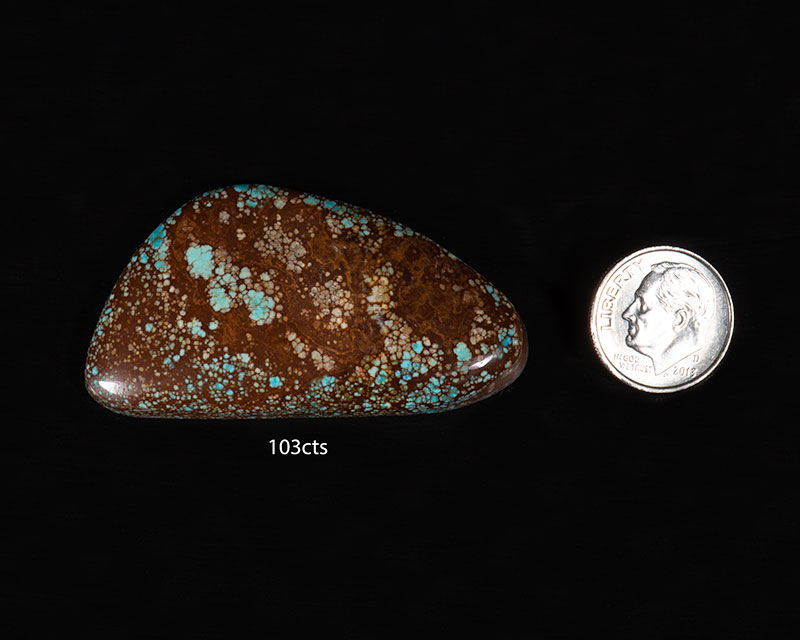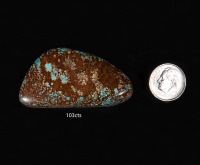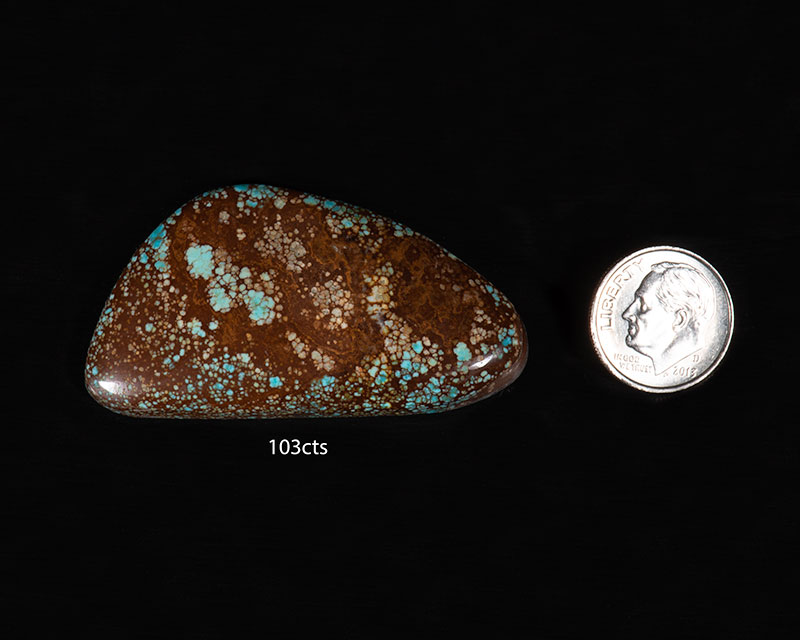Number Eight Turquoise 103 cts.



The number 8 mine was presumably discovered about 1925 by a barber from Carlin whose name has been forgotten, because he made no attempt to mine the property. The mine was rediscovered by Earl Buffington and Lawrence Springer in 1929. They filed formal claim to the property and proceeded to mine turquoise in serious fashion, producing about 1,800 pounds of good stone the first year. In 1930 Ted Johnson bought Buffington's interest and during the next four years produced about 5,000 pounds of commercial stone. In 1935 Doc Wilson bought the number 8 mine from Johnson but did nothing with the property and the claim lapsed. Myron Clark relocated the claim and, after working it for awhile, sold it to Lee Hand. Hand operated the mine for a short time, but became dissatisfied with the quality of the stone, and sold it to the five Edgar brothers who now own it. The Edgars extended operations and produced a considerable amount of fair-to-good turquoise.
In 1950, as most of the visible turquoise had been taken from the workings, the Edgars hired a contractor with bulldozer equipment to remove overburden from another part of the claim. A deposit of copper had been found on the property, and the Edgars thought they might mine copper if they did not find more turquoise. The bulldozer, after digging a pit about eight feet deep and 80 feet long, uncovered a deposit of some of the finest spider-web turquoise ever found in Nevada. The deposit was mostly in nodules, some of gigantic size.
One of the largest pieces of turquoise and matrix in the modern world, perhaps the largest nodule ever uncovered, was discovered at the Number 8 mine on June 23, 1954, by T. G. Edgar, J. M. Edgar, and Marvin Symes. This specimen was 33 inches long, 18.5 inches wide, and seven inches thick. Cleaned and polished it weighed 150 pounds. The nodule was of excellent texture, good color and hardness, and ranked with any turquoise of good commercial grade. Another nodule, of excellent quality, weighed more than nine pounds. It was sold to C. G. Wallace, of Zuni, New Mexico, for $1,600. The discovery proved to be a rather large-pocket and produced more than 1,600 pounds of the very highest grade turquoise before being worked out. Spurred by this find, the Edgars further explored the property, without finding any more spider-web turquoise of notable quantity. Other turquoise was discovered, however, of good commercial grade, sufficient to keep the mine in operation.
Of the ten claims in this 20-acre area, the Number 8, first claimed by the Blue Star Company in Lander County, is considered the finest example of the gold-webbed turquoise.. The mine has produced one of the most prized spider web turquoise deposits in the world. In its prime, enormous nodules were found, including one that weighed 150 pounds. Number 8 turquoise is famous for its black, golden-red and brown spider web matrix background, which is set off by the soft blue to blue green turquoise. Only rarely does gem material appear: a very dark blue turquoise with black spider web matrix. The mine is now depleted and Number 8 turquoise is extremely rare and valuable.
This 103 ct cab measures 29 x 53 mm. Unusually large piece of natural Number Eight. Would make a great bolo or pendant
 Previous
Previous
